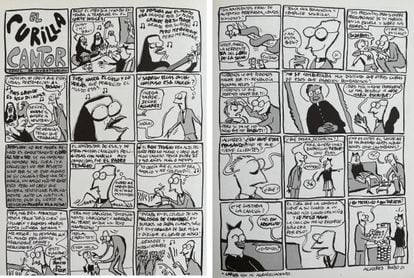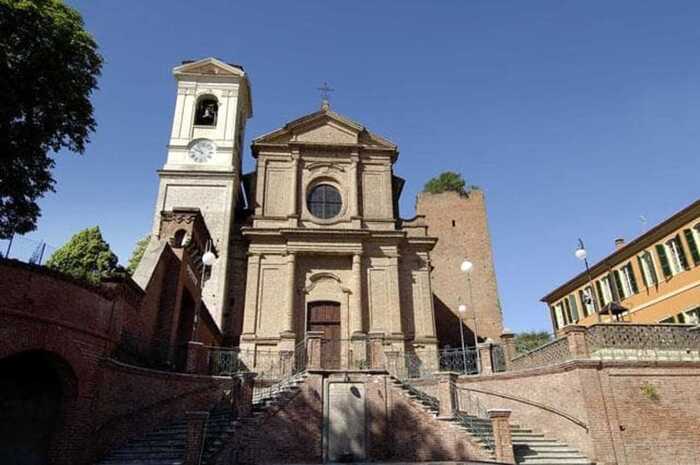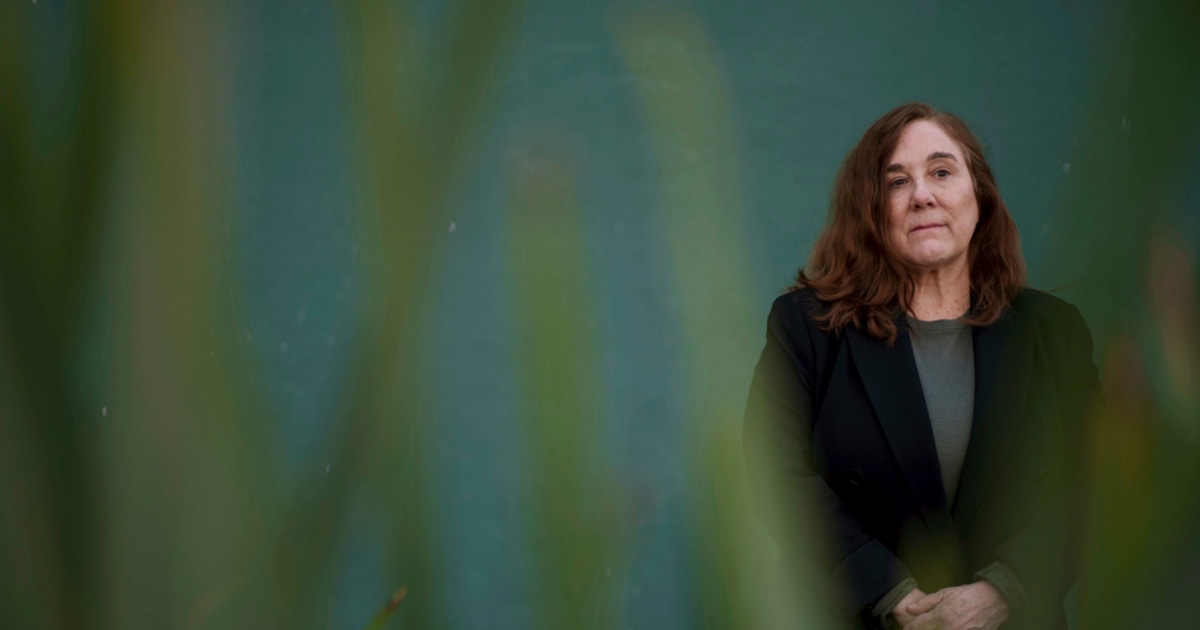Many former students of the Marist College of Chamberí, in Madrid, have not been taken by surprise by the accusations of pedophilia against the priest Cesáreo Gabaráin, personal prelate of John Paul II and known for being the composer of such famous mass songs as
Pescador de men
and
Together as brothers
. What's more, some still find it amazing that they didn't come to light years ago. “I always checked the news about abuse cases in the Church and it seemed strange to me that Cesáreo's name never appeared. He was known, by students and Marists, that he touched children in his office ”, affirms Francisco Javier García, a former student from Chamberí and alleged victim of Gabaráin in 1973.
When on August 8 he read in EL PAÍS that other colleagues denounced abuses by this priest in the seventies and that the order expelled him from school in 1978 after a complaint from several parents, he was encouraged to take a step to bring out “ the dark face ”of Father Cesáreo. "In his day
it was impossible to report it.
Now, 50 years later, the truth will be known about this scoundrel, ”he announces.
He is not the only one: five other people (three victims and two witnesses) tell this newspaper that the abuses of this priest actually go back at least 20 years before, at the very beginning of his priestly career.
They began already in 1959, the year in which he was ordained a priest in San Sebastián, in his first assignment in the Guipuzcoan municipality of Antzuola.
They continued in the first year he set foot in the Chamberí school, in 1966, and continued at least until 1978, when Gabaráin left this center and was relocated to the Salesian school of San Fernando, in Madrid.
In total, there are already eight
victims and four witnesses who accuse this priest of pedophilia and both the order and the archdiocese of Madrid of having concealed him. The impact of the news in many Catholic countries, from Poland to Latin America, where Gabaráin's songs are well known, has led Oregon Catholic Press (OCP), the US entity that has the licenses for his compositions, to temporarily eliminate them from its website the information about the priest and allocate the benefits of the rights to an organization that supports victims of pedophilia.
All the testimonies agree that Gabaráin's abuses were a well-known thing at the time.
Even in 2001, the comic artist Alvarez Rabo, a friend of one of those affected, published in the magazine
El Víbora
some cartoons about Cesáreo's practices, with a fictitious but easily recognizable name.
The abused ones expose the same
modus operandi
: the priest convinced them to go to his office or to his house and there, without using violence, he unbuttoned their clothes to touch their torso and genitals.
Consult the first database of pedophilia in the Church
EL PAÍS counts for the first time the cases of known abuses, which include sentences, journalistic investigations and public complaints that have uncovered the possible crimes of a Spanish religious.
The new accusations date back to 1959, the same year that Gabaráin was ordained a priest and assigned as chaplain to the Marist school and convent of Antzuola, a Gipuzkoan town of 2,000 inhabitants. Iñaki Badiola, 74, denounces that Gabaráin constantly touched children who went to mass or played sports with him. “He put together a team and it was our turn. Obviously everyone knew. Many times he invited us to his house to eat cookies and there he reached out to all of us ”, he details. Badiola says that, for years, he has warned his neighbors and the town council to avoid paying tributes to this priest. “One year they announced [in the village] that they were going to write a book about him. I sent them a registered letter to tell them that this guy was a pedophile. Nobody answered me, but everyone there knows it ”,assures. He stayed in Antzuola until 1964, at which time he was transferred as chaplain to the Zorroaga residence for the elderly (San Sebastián). There he spent two years before arriving in Madrid.
José Luis Álvarez, a former student from Chamberí, details that Gabaráin began abusing minors from the first moment he set foot in school, in 1966. Cesáreo, he says, took him to his office when he was 12 years old and gave him books on the subject sex for me to read. “When he came back, he hugged me and put his hand through the waistband of my pants to grope me both in front and behind. Once he called me while in class and I still remember when, when he left the classroom, Brother Julio, who was teaching us, looked at me with the face of knowing what was going to happen to me ”, he describes. One summer, he adds, Gabaráin tried to get him and four other students to go camping with him, but his parents refused. Over the years, Álvarez told his closest people about what happened, but says he always had the feeling that no one believed him.“It was a dark time. The priests had a lot of power ”, he emphasizes.
A comic in the magazine 'El Víbora'
Years later, this open secret about the abuse reached the ears of the well-known comic book author Alvarez Rabo through his friend Carlos, a former student of Chamberí and victim of the priest. “I saw a group of nuns and young girls singing mass songs next to a department store and was surprised. Shortly afterwards I mentioned this curiosity to my friend and he told me that the author was his teacher in the seventies and that he was dedicated to touching all the children of the Marist school. And I decided to do some cartoons ”, he relates. Using pseudonyms - Father Cesáreo became Father Tesáleo and the Marists, the “bad guys from Chamberí” - Alvarez Rabo described in two pages published in 2001 in the magazine
El Víbora
how the priest approached minors. "Fuck. It looks like the Ka snake from
The Jungle Book
"Says a child in one of the vignettes before the priest, represented in the shape of a snake in a tree while stalking two students.
Alvarez rabo
Carlos, the victim on whom the comic book story is based, has narrated to EL PAÍS the three episodes he suffered at the hands of Cesáreo during the course of 1968-1969. In all three, in one way or another, he managed to "escape" from him. “The third time, he took me to his office to show me the musical instruments and sat me on top of him. He started to touch me and I noticed he had an erection. I knew that this guy was a danger and I ran away. It was an extraterrestrial experience ”. Another former student, Emilio GF, who studied at the center between 1972 and 1974, states that these episodes were known to everyone, even those who "were lucky" not to be cited by Cesáreo. “They ran practical jokes between classmates every time a student, during class time, was called by Cesáreo to go to his office,” he says.These rumors also reached the ears of some parents.
Francisco Javier García says that Cesáreo began to “show interest” in him when he played on the basketball team during the course of 1973. He was 12 years old. Often I would come down to greet him in the locker room to congratulate him after games. On occasions, Gabaráin invited several of the players to have a snack in a cafeteria on the street of Santa Engracia in order, García says, to study who his victims could be. One day, this student asked him for help with a paper on the history of music. “He met me in his office one Saturday afternoon, when the school was practically empty. Upon entering, I felt strange. He showed me a record of the Russian romantics and explained who the author was while asking me to sit on his lap. I resisted, but in the end he grabbed me. While he was talking to me about music,he rubbed my back and lowered his hand to my ass. With the other hand I unbutton my pants and he lowered them ”, he narrates.
At that moment, García adds, he jumped off his lap and ran out of the office. “I was freaked out. In my fast run up the stairs I ran into brother Isidro, the head of the basketball section. He asked me what was happening and why I was running. I pushed him and continued my rapid descent. Just at that moment, Isidro saw Cesáreo coming after me while shouting: 'It's not what it seems, it's not what it seems,' "he says. García remembers that, after dodging brother Isidro, he heard that, as he angrily approached the priest, he shouted: "What doesn't seem like?" García did not say anything at home, but neither did Brother Isidro nor anyone from the school came to ask him about what had happened. “I stopped believing in the church and the priests. He considered them accomplices in this situation ”, he admits.
Facade of the Marist school in Chamberí (Madrid), where the priest Cesáreo Garabáin abused at least seven minors from 1966 to 1978.Olmo Calvo
"A mother filed a complaint with the archbishopric"
Calling the students to come to his office to touch them was a thing known to most of the students. Episodes that, between them, were cause for mockery and jokes. “One day, while we were waiting for a classmate at the school gate, we made fun of his delay because he was confessing to Cesáreo. We all knew it was one of the swipe sessions and we started talking about it. This boy's mother was behind us, she turned and asked us what we were laughing about. We all looked at the ground and she understood that something was wrong. He went up to Cesáreo's office and caught him at work. She was closely related to the bishopric and made her complaint. Neither was anything known afterwards, ”says García.
At that time, the archbishop of Madrid was Cardinal Vicente Enrique y Tarancón, also president of the Spanish Episcopal Conference. The Madrilenian bishopric assured this newspaper last week that it has no record in its files of any pedophile episode related to Gabaráin, only that in 1979 he was appointed vicar of the parish of Nuestra Señora de las Nieves, in the Madrid neighborhood of Mirasierra, until 1991, the year of his death at the age of 54. However, the diocese maintains that it will be firm in opening an investigation if a complaint reaches it. He affirms that he is next to the victims and encourages them to write to his email inforepara@archimadrid.es. On the other hand, the Marist order,Responsible for having communicated to Tarancón the alleged complaint of this mother in the early 1970s and the reasons for Gabaráin's expulsion in 1978, an investigation has already been opened.
Cesáreo Gabarain, in an archive photo.OCP
These accusations have fallen like a cold water jug for thousands of believers in many countries of the Catholic world, who for years have sung Gabaráin's lyrics. His songs also excited John Paul II, who in 1979, three months after Gabaráin left Chamberí, named him prelate of His Holiness, an honorary title granted to people of special relevance. The Oregon Catholic Press (OCP), an organization dedicated to providing musical resources and service to Catholic parishes around the world and an entity that has licenses for Gabaráin's compositions, reported this Wednesday in a statement that "with prudence" temporarily removed from its website "the pages with information on the profile of the composer, as well as their songs and products, including songbooks, records and scores",until the investigation of the Marists clarifies what happened. "The royalties that correspond to OCP as the publisher of their songs will be donated to an organization that supports victims of abuse," says the note.
For many, living with this priest and the possibility of abuse became a constant fear with which they had to learn to live. "That situation weighed heavily on you. The students saw it as a threat that we did not know how to describe ”, explains a former student of the Marist center. In his case, Gabaráin's passage through the school "broke his spiritual continuity with the Catholic religion." From the touching to his way of life, the behavior of this priest misled the students about what it was to be a good Christian. “This guy drove and did things that taught us that, to be a good Christian, you shouldn't do it. He used spiritual support as a mask to abuse minors ”, he specifies.
If you know of any case of sexual abuse that has not seen the light of day, write us with your complaint to
abusos@elpais.es


/cloudfront-eu-central-1.images.arcpublishing.com/prisa/JOUHOYP5TZF3RFHSGHG2XJTTLY.jpg)


/cloudfront-eu-central-1.images.arcpublishing.com/prisa/CDLMN2QW2RHKPMWXAHXMURZ2NA.jpeg)
/cloudfront-eu-central-1.images.arcpublishing.com/prisa/F67XMKSL7RXZEZQLMQFC62QYGE.jpg)








